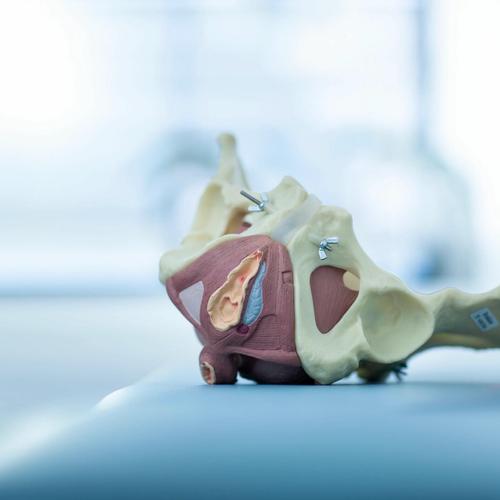Pelvic floor and manometry
Did you know that many abdominal complaints can be linked to the pelvic floor? Dr. Dropin Fysikalske has good expertise with ailments related to the pelvis and abdomen, and offers treatment, follow-up and individually tailored measures.
Check availability
What is the pelvic floor?
The pelvic floor muscles are the muscles in the lower abdomen and form the floor of the pelvis. Among other things, the pelvic floor ensures that we can retain urine, air and faeces, and provides a supportive effect for internal organs such as the bladder, uterus and bowels. In addition, the muscles have an important role for sexual function. Urine leakage or various forms of pelvic floor problems can affect everyone, both young and old, women and men, top-trained and non-top-trained. Pregnancy, childbirth and menopause are among the most frequent triggers for complaints.
Remember that you are not alone in having problems. We take the problems many people think are embarrassing to talk about seriously. At Dr. Dropin, we offer a pelvic floor examination by a physiotherapist with special expertise in women's health.
Manometry: measurement of pelvic floor function
Manometry measures changes in vaginal pressure, and can be considered as the gold standard for measuring the pelvic floor muscles in clinical practice. At Dr. Dropin, we offer a pelvic floor examination by a physiotherapist with special expertise in women's health.
We use manometry (Camtech), an objective measuring device that provides information about the function of the pelvic floor in terms of strength, endurance and relaxation. This is a standardized tool for examining strength in the muscles, changes during the course of treatment, and to motivate the patient to train the pelvic floor. This information is useful for individually adapting training plans and measuring progress, as this is difficult to measure in other ways.
The examination method is used, among other things, at the pelvic center at Ahus. Dr. Dropin is one of the few players who offers this service in central Oslo.
When do we use manometry?
- As part of the "Pelvic Check"
- Check of the pelvic floor muscles after pregnancy and childbirth
- Incontinence - Involuntary leakage of urine
- Prolapse / abdominal prolapse
- Pain conditions in the lower abdomen
Pelvic floor training
Pelvic floor training is the standard first-line treatment in Norway for urinary incontinence and abdominal prolapse. Guided strength training of the pelvic floor increases compliance and ensures that the patient performs the training correctly. 30% exercise the pelvic floor incorrectly, which in the worst case can worsen the symptoms. If you are unsure whether you are training the pelvic floor correctly, it is recommended to go to a qualified physiotherapist for guidance.
There is good documentation on the effect of strength training on the pelvic floor. A recent Norwegian study in which women trained the pelvic floor daily for 6 months achieved these great results:
• 74% experienced a reduced feeling of pressure and heaviness in the abdomen and felt less bulging in the vagina.
• 74% of women who had urinary leakage got better and 53% had reduced involuntary air leakage.
• Improvement of sexual function in 39% of women.
• The position of the urinary bladder was raised 4.3 mm and the bowel was raised 6.7 mm.
• The muscle opening in the pelvic floor (around the urethra, vagina and rectum) was reduced by 1.8 cm2.
Get to know our Physiotherapists
We know that the right competence and good chemistry are important. Below you can therefore get to know our therapists better. We hope this makes it easier to find a therapist who is right for you.



